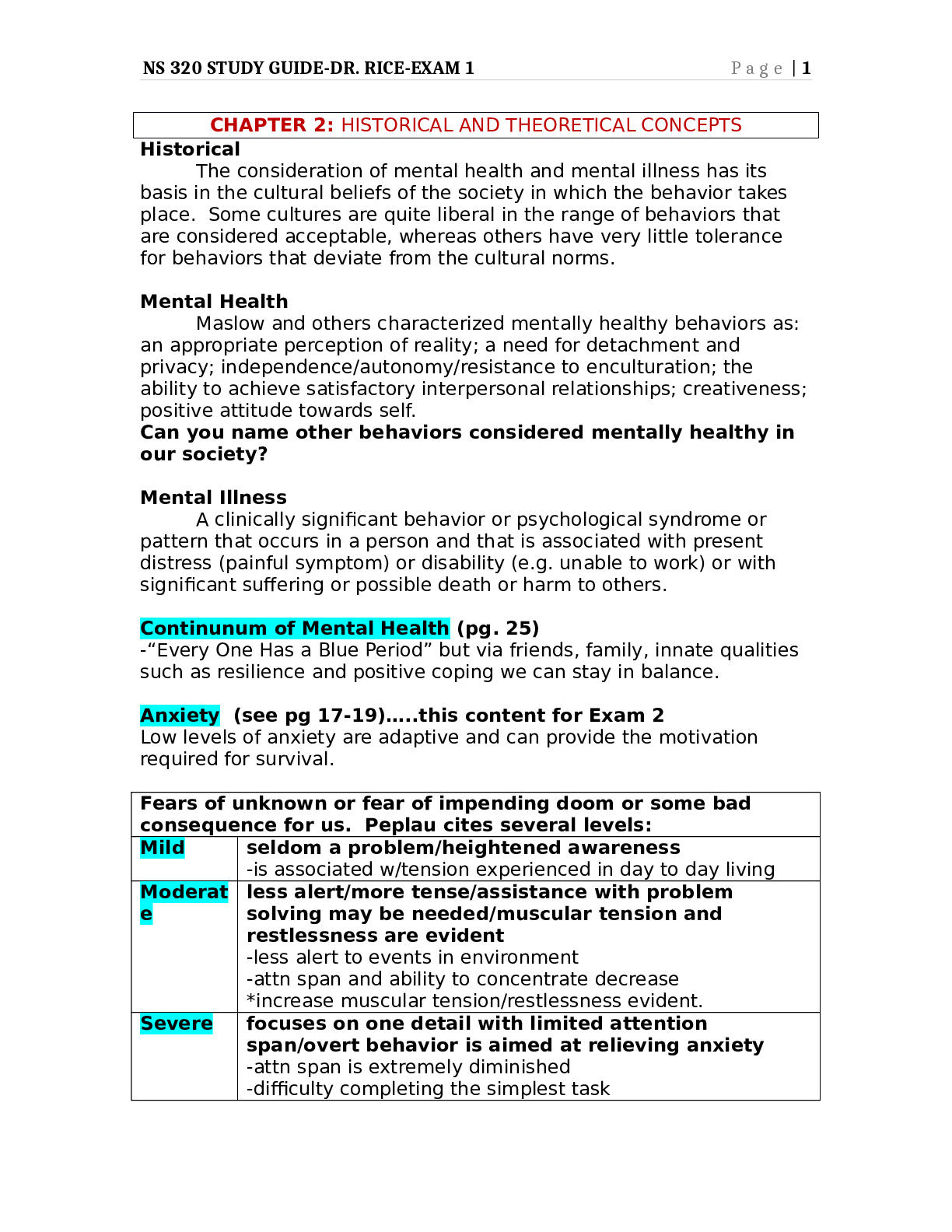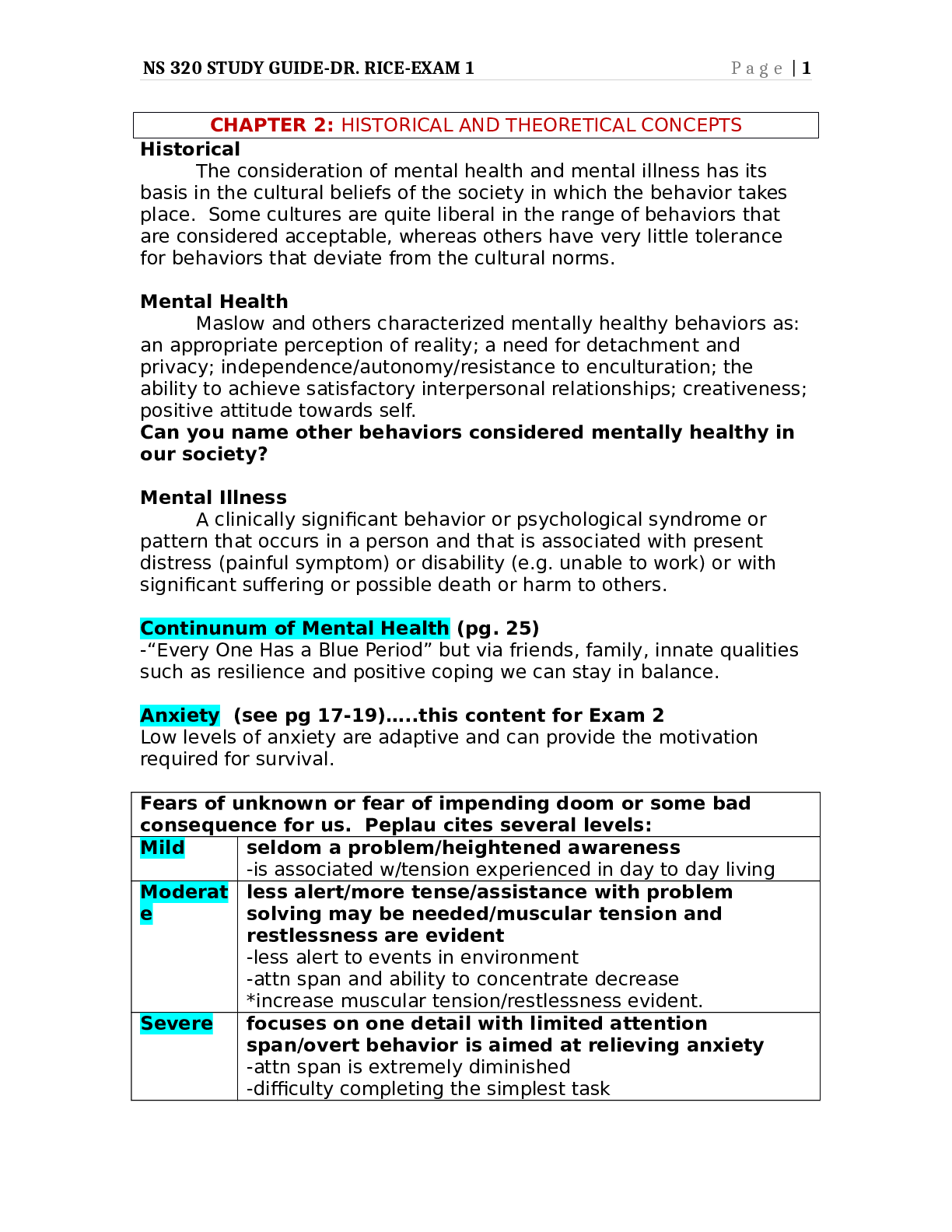CHAPTER 2: HISTORICAL AND THEORETICAL CONCEPTS
Historical
The consideration of mental health and mental illness has its
basis in the cultural beliefs of the society in which the behavior takes
place. Some cultures are quite liberal in the range of behaviors that
are considered acceptable, whereas others have very little tolerance
for behaviors that deviate from the cultural norms.
Mental Health
Maslow and others characterized mentally healthy behaviors as:
an appropriate perception of reality; a need for detachment and
privacy; independence/autonomy/resistance to enculturation; the
ability to achieve satisfactory interpersonal relationships; creativeness;
positive attitude towards self.
Can you name other behaviors considered mentally healthy in
our society?
Mental Illness
A clinically significant behavior or psychological syndrome or
pattern that occurs in a person and that is associated with present
distress (painful symptom) or disability (e.g. unable to work) or with
significant suffering or possible death or harm to others.
Continunum of Mental Health (pg. 25)
-“Every One Has a Blue Period” but via friends, family, innate qualities
such as resilience and positive coping we can stay in balance.
Anxiety (see pg 17-19).....this content for Exam 2
Low levels of anxiety are adaptive and can provide the motivation
required for survival.
Fears of unknown or fear of impending doom or some bad
consequence for us. Peplau cites several levels:
Mild
seldom a problem/heightened awareness
-is associated w/tension experienced in day to day living
Moderat less alert/more tense/assistance with problem
e
solving may be needed/muscular tension and
restlessness are evident
-less alert to events in environment
-attn span and ability to concentrate decrease
*increase muscular tension/restlessness evident.
Severe
focuses on one detail with limited attention
span/overt behavior is aimed at relieving anxiety
-attn span is extremely diminished
-difficulty completing the simplest task
NS 320 STUDY GUIDE-DR. RICE-EXAM 1
Page | 2
*H/A, palpitations, insomnia, confusion, dread, horror
ALL behavior is aimed at relieving anxiety.
Panic
most intense state/may experience hallucinations or
delusions/characterized by wild or extreme actions...
can be life threatening.
-cannot focus on even “one” detail in the environment.
-misconceptions are common
-losing touch with reality is common
-hallucinations/delusions
-human fxing and contact are ineffective
*Can be life threatening
Key nursing intervention is to take control of the situation and
keep client safe.
Ego Defenses
Defense mechanisms (Anna Freud) employed by the ego in the
face of some biological or psychological threat. Can be maladaptive
depending to the degrees the interfere with one’s ability to deal with
reality.
Know table 2-2 on pg 20.
Related Terms:
Neurosis (seen with Severe
Anxiety)
Psychosis (seen with Panic
Anxiety)
appears as a symptom such as an
obsession or phobia.
loss of ego boundaries with gross
impairment of reality testing.
Grief (know Kubler-Ross’s 5 stages --on pg. 24)
1)Denial
Shock and disbelief; Reality of loss not acknowledged
Protective mechanism........
NO, it
can’t be true
2)Anger
Envy and resentment towards those not affected by the
loss are common
WHY me, IT’S not fair
3)Bargainin Ex: God if you help me through this, I promise I will go to
g
church
4)Depressio Full impact of loss is experienced
n
5)Acceptan A feeling of peace regarding the loss
ce
Anticipatory Grief vs Maladaptive Grief (pg. 25)
Anticipator When a loss is anticipated, individuals often begin the
y
work of grieving before the actual loss occurs.
Can decrease the duration and intensity of the mourning
NS 320 STUDY GUIDE-DR. RICE-EXAM 1
Page | 3
period
Maladaptiv
Individual is not able to progress through the stages of
e
grieving and achieve resolution.
-individual may be fixed in the denial stage
Prolonged- intense preoccupation with memories of the
lost entity for many years
Delayed or inhibited- fixed in the denial stage
Emotional pain is not
experienced, but
Anxiety disorders, or sleeping
and eating
disorders are evident.
TEST ?’s
Patients learn with MILD anxiety
1. A client hates her mother because of childhood neglect. The
nurse determines which client statement represents the use of
the defense mechanism of reaction formation?
A) “I don’t like to talk about my relationship with my
mother.”
B) “My mother hates me.”
C) “I have a very wonderful mother whom I love very
much.”
D) “My mom always loved my sister more than she loved
me.”
DSM-IV-TR Multiaxial Evaluation System
• Axis I: Clinical disorders and other conditions that may be
a focus of clinical attention
• Now Focuses on Axis I with Primary Psych Disorder
• Depression, bipolar, schizophrenia
Nclex tips
Be able to identify mentally healthy behaviors
keep job, good relationships, enjoys life
Recognize that clients go to the hospital with threat to self or
other or inability to safely care for theirselves; or detox issues;
Or drug seeking issues or sometimes just needing a bed if
homeless
Chapter 8: Therapeutic Communication (9 questions)
Therapeutic communication-
are specific communication techniques to help nurses provide care to
clients requiring psychosocial intervention. Be aware that ones own
values, attitudes, and beliefs can influence communication in
numerous ways.
Read More


